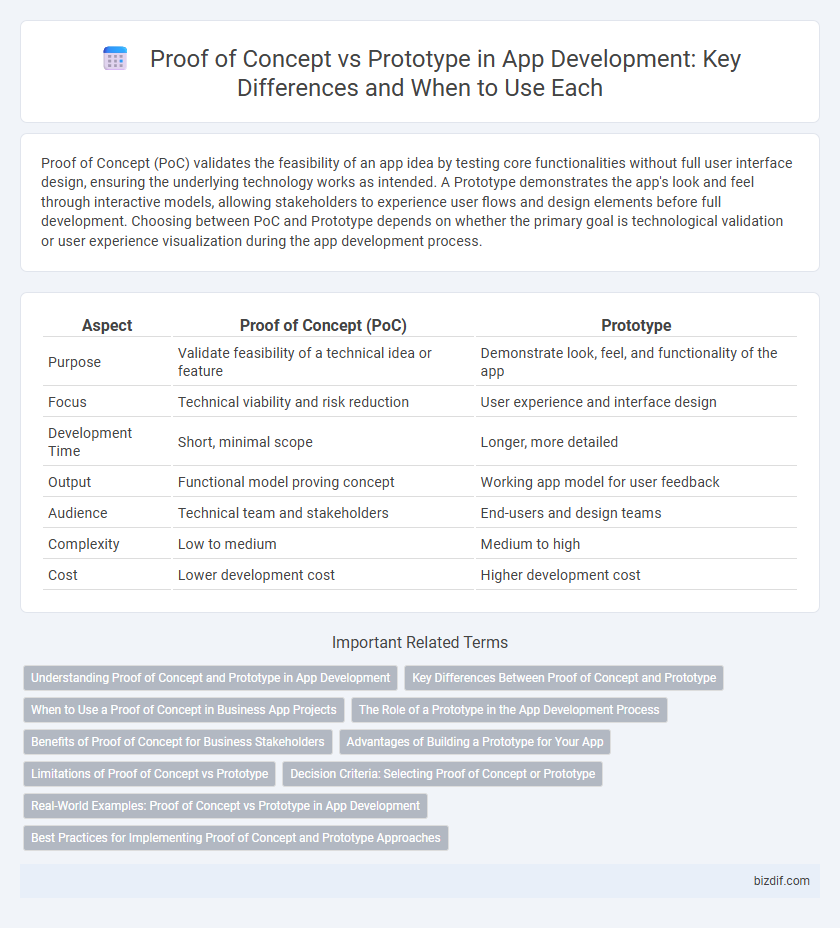Proof of Concept (PoC) validates the feasibility of an app idea by testing core functionalities without full user interface design, ensuring the underlying technology works as intended. A Prototype demonstrates the app's look and feel through interactive models, allowing stakeholders to experience user flows and design elements before full development. Choosing between PoC and Prototype depends on whether the primary goal is technological validation or user experience visualization during the app development process.
Table of Comparison
| Aspect | Proof of Concept (PoC) | Prototype |
|---|---|---|
| Purpose | Validate feasibility of a technical idea or feature | Demonstrate look, feel, and functionality of the app |
| Focus | Technical viability and risk reduction | User experience and interface design |
| Development Time | Short, minimal scope | Longer, more detailed |
| Output | Functional model proving concept | Working app model for user feedback |
| Audience | Technical team and stakeholders | End-users and design teams |
| Complexity | Low to medium | Medium to high |
| Cost | Lower development cost | Higher development cost |
Understanding Proof of Concept and Prototype in App Development
Proof of Concept (PoC) in app development validates the feasibility of an idea or technology to ensure it can be successfully implemented. A Prototype, on the other hand, is an early, interactive model of the app that demonstrates user interface and experience, allowing stakeholders to visualize functionality and gather feedback. Understanding the distinction helps developers allocate resources effectively and streamline the app development process.
Key Differences Between Proof of Concept and Prototype
Proof of Concept (PoC) validates the feasibility of an idea or technology, focusing on proving that a concept can be implemented technically. A Prototype is a working model of the final product designed to demonstrate functionality, design, and user interaction, often used for user feedback and iterative improvements. PoCs are typically small-scale and limited in scope, while prototypes are more comprehensive and interactive representations of the app.
When to Use a Proof of Concept in Business App Projects
A Proof of Concept (PoC) in business app projects is essential when validating the feasibility of a critical technology or innovative feature before full-scale development. PoCs help stakeholders assess technical risks and ensure alignment with business goals by demonstrating core functionality through minimal viable implementation. Employing a PoC early in the app development lifecycle reduces costly failures and accelerates decision-making for complex or unproven solutions.
The Role of a Prototype in the App Development Process
A prototype in app development serves as a functional model that allows developers and stakeholders to visualize user interface designs and validate core features before full-scale production. It helps identify usability issues, refine workflows, and gather user feedback early, reducing costly changes in later stages. Unlike a proof of concept that tests feasibility, a prototype demonstrates practical application and user experience, bridging the gap between concept and final product.
Benefits of Proof of Concept for Business Stakeholders
Proof of Concept (PoC) validates the feasibility and technical viability of an app idea, reducing investment risks for business stakeholders. It provides early insights into potential challenges and market fit, enabling data-driven decision-making before full-scale development. PoC also accelerates stakeholder buy-in by demonstrating core functionality, streamlining resource allocation and minimizing time-to-market.
Advantages of Building a Prototype for Your App
Building a prototype for your app offers clear advantages such as tangible user interaction, allowing real-time feedback and iterative improvements before full development. This approach reduces risks by identifying design flaws early and aligns stakeholder expectations through visual and functional clarity. Prototypes also accelerate decision-making processes, saving time and resources by refining features based on actual user experience.
Limitations of Proof of Concept vs Prototype
Proof of Concept (PoC) often has limited functionality and is designed solely to demonstrate the feasibility of a specific idea, lacking the user interface and refined features. Prototypes, in contrast, provide a more interactive and visual representation of the app, but may still lack full backend integration or performance optimization. PoCs cannot fully simulate real-world user interactions, while prototypes may not cover all technical constraints or scalability issues.
Decision Criteria: Selecting Proof of Concept or Prototype
Selecting between a Proof of Concept and a Prototype hinges on project goals and timeline constraints. Proof of Concept is ideal for validating technical feasibility or specific functionalities early in the development cycle, minimizing risk before committing significant resources. Prototypes are better suited for user experience testing and design validation, offering interactive models to gather stakeholder feedback and refine final app features.
Real-World Examples: Proof of Concept vs Prototype in App Development
Proof of concept (PoC) in app development demonstrates the technical feasibility of a specific functionality, such as Uber's initial concept verifying GPS-based ride matching before full app creation. Prototypes, like Airbnb's early app mockups, focus on user experience and interface design to gather feedback and iterate on features. While PoCs address "can it work?" questions, prototypes test "how will users interact?" in real-world scenarios.
Best Practices for Implementing Proof of Concept and Prototype Approaches
Implementing best practices for Proof of Concept (PoC) and prototype approaches in app development involves clearly defining objectives and success criteria to validate feasibility and user experience effectively. PoCs should focus on testing core functionalities and technical viability with minimal resources, while prototypes emphasize user interface and interaction design to gather early user feedback. Iterative testing, stakeholder collaboration, and using appropriate tools such as wireframing for prototypes and automated testing for PoCs enhance development efficiency and reduce risks.
Proof of Concept vs Prototype Infographic

 bizdif.com
bizdif.com